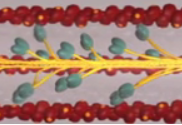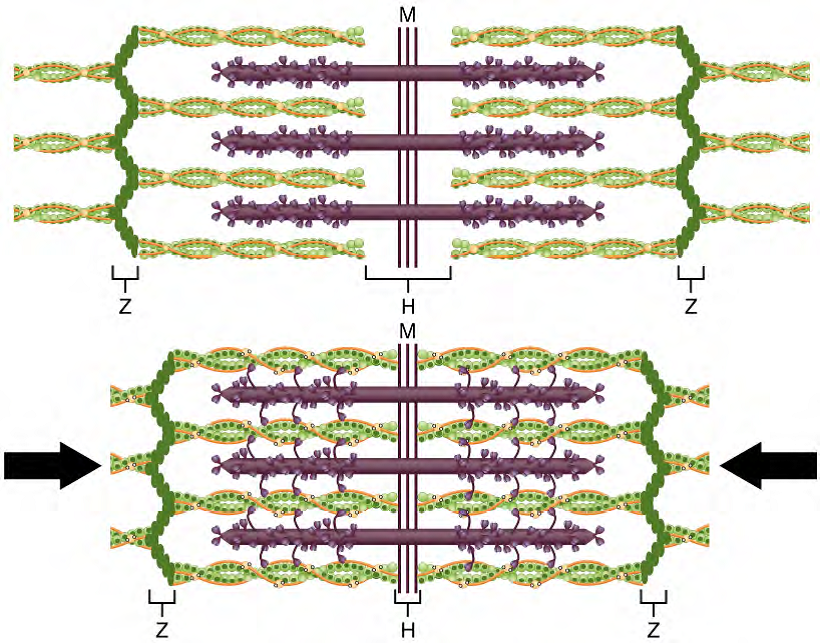More Detail on the Steps of the SFT
The order of these steps can be remembered with the mnemonic "Have A Perfect Day" and it can be useful to visualize these steps by imagining rowing a boat. When you sit down in the boat you grab the oars and position them over the water in the "ready" position (step 1). Then you place the oars in the water forming a cross bridge between the oar and the water (step 2). Next is the hard part, pulling the oars (power stroke) through the water to propel your boat forward - sliding over the water (step 3). Lastly, you lift the oars out of the water because one power stroke is not enough to reach your destination (step 4). Energy (new ATP molecule) is used to bring the oars that are in front of you from step 4 to the ready position behind you in step 1 so that you can continue to move across the lake toward your destination.
I do want to clarify that there are several myosin heads protruding from the myosin filament and each head is performing the steps of the Sliding Filament Theory when stimulated by calcium release. So far we have only mentioned one myosin head pulling on the actin filament but there are 20 or more per side of the sarcomere. Each myosin head is operating independently and in a non-synchronized fashion as the other myosin heads. This means that while some myosin heads are in step 2 others are in step 1, 3, and 4. This is useful so that the filaments don't have to start over every time they pass through step 4 of the Sliding Filament Theory. What I mean by this is ... in the game of tug-of-war does everyone on your team let go of the rope at one time to try and grab further down and pull the opposite team toward you? No, each player is operating independently toward the common goal. Some players pull while other release their hands to grab further down the rope, and then the roles become reversed, continuing on until the common goal is reached.

Figure 9. This image illustrates how many myosin heads could be pulling on the actin at one time.

Figure 10. The motions of oars used in a rowboat can be compared to myosin heads in the Sliding Filament Model

Figure 11. The Sliding Filament Model of Muscle Contraction. When a sarcomere contracts, the Z lines move closer together, and the I band becomes smaller. The A band stays the same width. At full contraction, the thin and thick filaments overlap.
The Sliding Filament Theory continues on until maximum contraction has been reached. Now we must turn the contraction off, but how? The first step is for the brain to stop sending action potentials down the somatic motor neuron. This will happen when the brain is satisfied that the work it intended to start has been completed or another stimulus that takes precedence over the current work is received. By stopping the action potentials at the source, the somatic motor neuron stops releasing ACh into the synaptic cleft. This neurotransmitter must be removed so that the ligand gated sodium channel receptors can close preventing further depolarization of the sarcolemma. This removal of ACh can happen in 3 ways. The first is that ACh can simply diffuse away. There are no boundaries or enclosures of the synaptic cleft keeping the ACh in the cleft. This means that ACh following its concentration gradient can simply exit or diffuse out of the cleft. The second method of removal is enzymatic degradation of ACh by the enzyme acetylcholinesterase. This enzyme breaks ACh down into acetate and choline - these products do not bind to the very specific ligand gated channels meaning that when the ACh is broken down it can no longer cause depolarization of the sarcolemma. Then last, the choline component of ACh can be taken back up by the somatic motor neuron removing it from the cleft. Your body recycles everything it can to prevent unnecessary energy expenditure, so this reuptake of the ACh components after the enzyme degrades it not only makes sense but is incredibly efficient.

